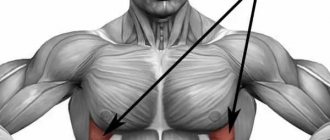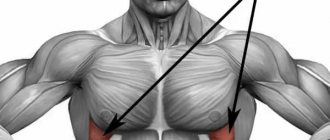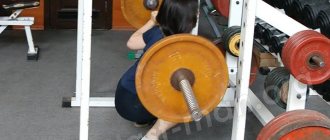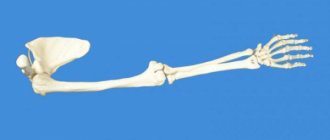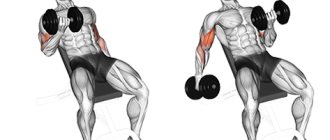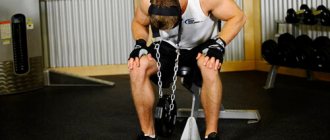Functions
The breathing process consists of 2 parts: inhalation and exhalation. During deep inhalation, the size of the chest cavity is increased to allow additional air into the lungs. The external intercostal muscles are stimulated during deep inspiration to lift and spread the ribs.
The external intercostal muscles expand the rib cage, lifting and lengthening the chest. They are innervated by intercostal nerves originating in the thoracic segments of the spinal cord. The contraction of these muscles lifts the rib cage up and out, thereby expanding the chest cavity and reducing the pressure inside the lung, forcing air into the lungs.
A deep exhalation works similar to a deep inhalation, but uses the internal intercostal muscles to pull the ribs lower and closer together. When the ribs are compressed, the volume of the chest cavity decreases, resulting in the escape of air from the lungs.
Exercises for the latissimus muscles in the gym
- Pull of the upper block to the chest. One of the back exercises, but not the most effective. Set the weight, take the handle with a wide grip, and pull it to the top of your chest. At the same time, there is a natural deflection in the lower back. The body is slightly tilted back. Watch the position of your elbows; they should not go back or forward.
- Lower block thrust. It is performed both on a separate simulator and in a crossover. Sit with your feet planted, knees slightly bent, back straight. The body forms a right angle, grab the handle with both hands. Pull towards your stomach. Elbows point down, chest forward during the pull.
- Pullover. The main muscle that works during this exercise is the chest. However, an effective load also falls on the latissimus dorsi muscles. Lie down on a bench and hold the dumbbell straight in front of you, perpendicular to the floor. With straight arms, lower it behind your head, straining your back.
- Bent-over barbell row. Take a standing position, knees slightly bent, body tilted forward. The back is straight, the grip is slightly wider than the shoulders. Tightening your back muscles and biceps, pull the barbell towards your upper abdomen.
- T-bar row. Place a barbell with a weight between your legs. The back is straight, a slight bend in the knees, the body is tilted. Pull the bar towards you, tensing all your back muscles, and slowly lower it.
Structure
The 22 pairs of intercostal muscles are divided into two groups: 11 pairs of internal and 11 pairs of external. Each rib is connected to the other rib below it by both the external and internal intercostal muscles. The twelfth rib is an exception, as it is the lowest rib.
The figure shows the location of the external and internal intercostal muscles.
The external intercostal muscles are located along the lower borders of the first 11 ribs. The fibers of the external intercostal spaces pass obliquely. Contraction of the external muscles lifts the ribs and pushes them apart.
The internal intercostal muscles are located along the upper border of the second through twelfth ribs, and their insertions form along the lower borders of the upper rib.
The fibers of the internal intercostal space pass obliquely above and behind at right angles to the fibers of the external intercostal space. The contraction of the internal muscles puts pressure on the ribs and pulls them closer together. The intercostal muscles form two thin layers that span each of the intercostal spaces.
These spaces contain two layers of muscles in the lateral part and one layer in the ventral part. The external intercostal muscle in this region, however, is duplicated in each space by a thin, triangular-shaped muscle that originates from the tip of the transverse process of the vertebra and fans out to the side.
Start and Attachment
The PSM originates on the anterior surface of the eight or nine upper ribs and is inserted on the medial border of the scapula.
We recommend reading: Lack of sun and vitamin D
Conventionally, this muscle is divided into three parts:
- Upper: 1st-2nd rib → upper corner of the shoulder blade.
- Middle: 2nd to 3rd rib → medial edge of scapula.
- Inferior: from the 4th to the 9th rib → medial edge and lower angle of the scapula. This is the most powerful and outstanding part.
Innervation and blood supply
The PZM is innervated by the long thoracic nerve (C5-C7 roots of the brachial plexus). The blood supply to this muscle is provided by the lateral thoracic, superior thoracic and thoracodorsal arteries.
Essence and basic principles
While the ribs protect the lungs, the muscles help the lungs expand and contract. A person uses the intercostal muscles every day to laugh, speak and simply breathe. Strengthening these muscles will increase your lung capacity and improve your respiratory system.
According to the American Council on Exercise, strengthening the intercostal muscles and diaphragm increases the efficiency of the respiratory system by expanding and strengthening the lungs. This means a person can take in more oxygen to fuel muscles during exercise and sports. These benefits apply not only to athletes, but to all people.
The intercostal muscles are located between the ribs, which means exercises should focus on these and the closest areas - the external oblique abdominal cavity, located on the sides, in the front of the torso, which extends from the last ribs to the iliac spine.
Indications for use
The intercostal muscles are located in a place where they are difficult to injure. They get injured due to sudden movements, when a person suddenly bends or twists the upper body. The speed of recovery depends on the gradation of muscle tension, which indicates the degree of injury.
Muscle tension can be represented in a small table as follows:
| Voltage level | Symptoms |
| 1st degree | Low muscle tension, only some muscle fibers are damaged. Recovery time takes about two to three weeks. |
| 2nd degree | Moderate muscle tension, most muscle fibers are involved, but the muscles are not torn. Recovery time: three to six weeks |
| 3rd degree | Severe injury, complete muscle rupture. Surgery is often necessary. Recovery may take up to three months. |
Muscles are used during vigorous activities that involve twisting the torso, especially when lifting heavy objects or overextending the arms. In sports, these injuries can be caused by poor warm-up, improper execution of the exercise, or training too hard.
Exercises for the intercostal muscles will not only help you avoid injuries in this area, or recover faster from their consequences, but will also make your breathing cleaner and help you cope with shortness of breath.
When a person runs, he breathes much harder and more often than when he is not engaged in active activity. The intercostal muscles allow more air to enter the lungs. Therefore, these muscles help the body adjust to all the inhalations and exhalations required during exercise.
Without them, the body would not be able to adapt to the physiological changes that come with exercise. This is why strong intercostal muscles increase endurance and reduce shortness of breath.
The intercostal muscles are located where they are responsible for controlling breathing. Therefore, due to insufficiently developed muscles, people feel cramps, fatigue, and lack of oxygen during physical activity. Thus, strengthening the intercostal muscles has its benefits, such as improved posture and breathing.
Features of the training
In fitness, there are no secret exercises to pump up your serratus muscles. They are involved in most movements that are aimed at developing the pectoral, deltoid and back muscles. The muscle is also partially involved in some abdominal movements. Therefore, you can often come across the wording “serratus abdominal muscles” (although anatomically it is not correct).
The main problem on the way to pronounced hypertrophy of the desired muscle is its function. It is very difficult to perform a movement in which the rest of the muscles do not take on the entire load. This requires special conditions when performing exercises, as well as carefully selected weight (mostly the work is carried out with light weights).
The main sports in which this muscle is involved:
- Strength sports (bodybuilding, weightlifting, powerlifting).
- Swimming (works in all styles and techniques).
- Disciplines where there are throwing and pushing elements.
- Artistic gymnastics (while holding on rings, uneven bars, etc.).
- Martial arts and other sports in which the shoulder girdle is actively involved.
Therefore, the main sport in which muscles are trained to increase volume is bodybuilding. Mostly we are talking about a competitive career, where the form can give an additional advantage and give aesthetics to the figure in some positions.
It is also worth noting that the pronounced serratus muscle in professional bodybuilders is largely the result of competent posing than targeted development. Genetics also plays an important role, which determines the shape (for some athletes it stands out noticeably even without additional exercises).
Contraindications for use
Contraindications to performing exercises on the intercostal muscles are quite rare, because do not require serious physical exertion. Often the restrictions are temporary. If a person feels significant pain in the areas near the intercostal muscles, then first of all he should consult a specialist.
Also, people who have or have had injuries in the intercostal muscles, diseases in the lungs, abdomen, ribs, or if operations have been performed in these areas should approach the exercises with caution.
Clinical relevance
Pterygoid scapula
Dysfunction of the serratus anterior muscle is one of the causes of pterygoid scapula. Weakness of the scapula leads to overactivity of the shoulder abductors, resulting in downward and internal rotation of the scapula and anterior tilt during shoulder abduction and flexion. If this position is maintained for a long time, adaptive shortening of the pectoralis minor may occur, causing the scapula to tilt further forward and rotate internally. Thus, the pterygoid scapula is caused by weakness of the PZM.
Scapula protrusion during wall push-ups
The most common cause of PSM paresis is damage to the long thoracic nerve (C5-7). The long thoracic nerve descends along the lateral chest wall, making it susceptible to injury during surgery on the anterolateral chest.
Other causes of isolated PPM palsy include trauma, strenuous work, athletics, anesthesia, infection, and idiopathic causes. Neuropraxia of the long thoracic nerve may result from compression or stretching.
Subacromial impingement
Weakness of the rotator cuff leads to dysfunction of the rotator cuff muscles, which increases the risk of subacromial pain syndrome.
You can read more about subacromial pain syndrome here.
In addition, the PSM is necessary for scapular upward rotation, posterior tilt, and, to a lesser extent, external rotation of the scapula. This is necessary to maintain the volume of the subacromial space and reduce the risk of subacromial impingement.
Myofascial lesion of the serratus anterior muscle
Chronic chest pain of noncardiac origin is a heterogeneous disorder. For example, one of the reasons may be myofascial pain syndrome, in which several functional muscle units are often affected (so-called trigger points are formed in them). The syndrome includes a set of symptoms, one of which is pain localized in the area of the 5th-7th ribs in the midline. Referred pain may spread along the anterior chest wall and medial arm, reaching the little and ring fingers. This pain may be intermittent or constant.
Trigger point PZM syndrome may also occur
- pain between the shoulder blades,
- golfer's elbow,
- pain in the ribs and arm.
Differential diagnosis
Intercostal neuralgia
This condition can be differentiated by palpation. In the case of PPM syndrome, palpation of trigger points will cause pain that occurs spontaneously. With intercostal neuralgia, palpation does not cause pain, because Neuralgia pain is located along the dermatome.
Main complex
It is impossible to use the intercostal muscles alone, because they are not the only ones involved in the breathing process. Only when the body works in a coordinated manner do the intercostal muscles expand the ribs.
Ideally, when a person exercises properly, their chest moves last and least. Breathing exercises, special training movements, and even yoga poses help strengthen the intercostal muscles.
Deep breathing
The sequence of actions when performing the exercise should be as follows:
- Stand up to your full height, or sit down, keeping your back and neck straight.
- Inhale as deeply as possible, but so that the inhalation does not cause discomfort, then relax.
- Focus on breathing with the lower part of your lungs (it is advisable not to raise your shoulders).
- Repeat the exercise 5 times.
For optimal performance of the exercise, the ribs should be free, not constrained or pinched. To do this, it is important to straighten your back. This will also stretch the intercostal muscles.
To prevent cramps, your last meal should be at least an hour ago. While deep breathing exercises like this may make you feel a little dizzy, this is completely normal.
Foam roller
You need to place a special training roller under your upper back. Breathe normally, keeping your back and neck relaxed. You need to hold this position for 15 to 90 seconds, provided that it is comfortable and does not cause pain. This exercise can be performed by raising your arms above your head.
Rotation while lying down
To start the exercise, you need to lie on your back. Bend your legs and slowly raise your knees, and then tilt them to one side and the other. Repeat 10 times.
Dumbbell Pull-Up
First you need to lie on your back, on a bench, make sure that your head, neck and both legs are lying flat. Hold one dumbbell with both hands directly above your chest, maintaining a slight bend at the elbows. Then lift the dumbbell up and lower it behind your head as far as possible. Repeat 5-10 times.
Side plank
An exercise to strengthen the lateral abs and intercostal muscles at the same time. You need to lie on your side, place your bent arm parallel to your shoulder, while it should be extended to the side, at approximately an angle of 90 degrees relative to the shoulder.
Place your feet on top of each other so that your legs are together, then stand on your own forearm. The second hand needs to be placed on the body - it does not participate in the exercise in any way. This exercise is a variation of the plank. You need to repeat on both sides.
Slant heel
You need to lie on the floor with your knees bent, your feet should rest on the floor with their entire surface. The knees are pointing straight up. Looking at the ceiling, you need to slightly raise your head, neck and shoulders. Keeping your arms at your sides, reach for one heel. Then return your hand to its original position and repeat the same on the other side.
Intercostal Breathing
To perform intercostal breathing, you need to stand and extend both arms above your head. Take a deep breath and, as you exhale, extend your arms to the right, stretching the intercostal muscles on the left side of the body. As you exhale, return to the starting position; on the next exhalation, extend your arms to the left, stretching the intercostal muscles of your right arm. Repeat the exercise twice on each side.
Cat pose
You need to get on all fours, align your knees with your hips and your hands with your shoulders. As you inhale, raise your head and tailbone. As you exhale, round your back. Repeat this pose at least 10 times.
Weekly exercise schedule
Each workout should begin with a short run. It is during running, when a person begins to breathe harder, that the work of the intercostal muscles is most clearly visible. It is impossible to clearly select exercises for everyone, because all cases are individual. In one workout you need to perform 4-5 of the exercises listed above.
Start with easier exercises and gradually move on to heavier ones.
It's worth doing three workouts a week. Over time, when the body gets used to the stress, you can switch to four workouts per week. Each person must modify their exercise schedule themselves, because all people have different physical shape, different characteristics of strength, endurance and flexibility of the body.
People with different levels of fitness will perform one exercise differently. I don’t know the physical form of a person; it is impossible to give the exact number of exercises, the time to perform them, and especially the weights with which to work. That is why a person must be exposed to adequate stress, depending on his physical readiness.
Below is an example of what a schedule might look like; you can take this as a basis and, based on the above schedule, create your own:
| Monday | Wednesday | Friday |
|
|
|
Rest
Although the exercises themselves do not require significant physical exertion, excessive use of the intercostal muscles can lead to injury or strain. Therefore, you need to allow enough time for recovery between workouts.
How to pump up the serratus muscles
To understand how to pump up the serratus muscle, you don’t need a lot of knowledge.
There are no specialized complexes for isolated pumping.
If you need to improve its shape, try the following:
- Mental concentration
The first and most important rule is to focus on the work of the muscle when performing all exercises where the serratus is involved.
- Use a pullover with a dumbbell
Be sure to include this exercise in your training complex.
If the target group feels bad about it, experiment with other implementation options.
The goal is to achieve a movement technique where maximum engagement of the gears occurs.
- Light working weight
For greater impact on the serratus anteriors, it is recommended to use light weights in the exercises.
Focus on correct execution technique and mental concentration.
Typically, exercises are performed in the range of 10-15 times. In this case, weights of 50-60% of one repetition maximum are used.
Consolidate the result
In addition to exercise, there are other ways to strengthen the intercostal muscles. Some of them relate to situations where a person is already experiencing pain and discomfort in this area, the other part is useful, even if there is no visible discomfort.
If a person has already been injured, or is experiencing pain and discomfort, then the following actions should be taken:
- Protection. It is necessary to protect the muscles from discomfort so as not to aggravate the situation. Specifically, you need to avoid activities that cause pain. For example, twisting the torso.
- Rest. In fact, this point also applies to protection. You need to give your muscles a rest and disturb them less. Avoid activities that involve heavy and rapid breathing. For example, physical activity.
- Splinting or fixing the damaged area.
- Cold: Ice packs applied to the painful area for the first 48 hours help reduce inflammation. Apply cold objects, ice packs, or frozen foods for ten to fifteen minutes every two to four hours. Ice should not come into contact with bare skin because there is a risk of burns. Exactly the opposite action - high temperature and warming ointments are good for spasms and muscle stiffness.
- Painkillers. One of the best over-the-counter painkillers is paracetamol because it has very few side effects. Anti-inflammatory drugs can delay healing in the first 72 hours. They should be used with caution and only on the advice of a doctor.
If there is no visible discomfort and you need to strengthen the intercostal muscles, then you can take the following actions:
- Manual Therapy: Hand care including soft tissue massage, stretching and joint mobilization by a physical therapist to improve thoracic spine mobility. Using mobilization techniques also helps relieve pain.
- Neuromuscular re-education: correct posture. A person must learn to sit correctly, not slouch, and even sleep in the correct positions; sometimes the use of a corset is recommended.
- Dry needling. When done correctly, it is a very effective method. It should be carried out only after consultation with a person who has sufficient knowledge and experience in this area.
The first effect of the exercises will occur in about two to three weeks. The internal and external intercostal muscles, due to their location in the body, stabilize the midsection of the body and help perform common tasks such as bending, walking and twisting.
This means that a person will feel the effectiveness of exercise in everyday life. In the long term, strong intercostal muscles will help improve posture and reduce shortness of breath.
